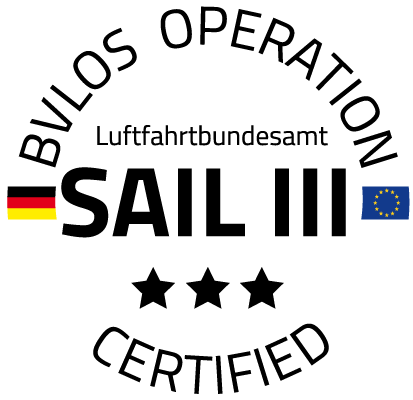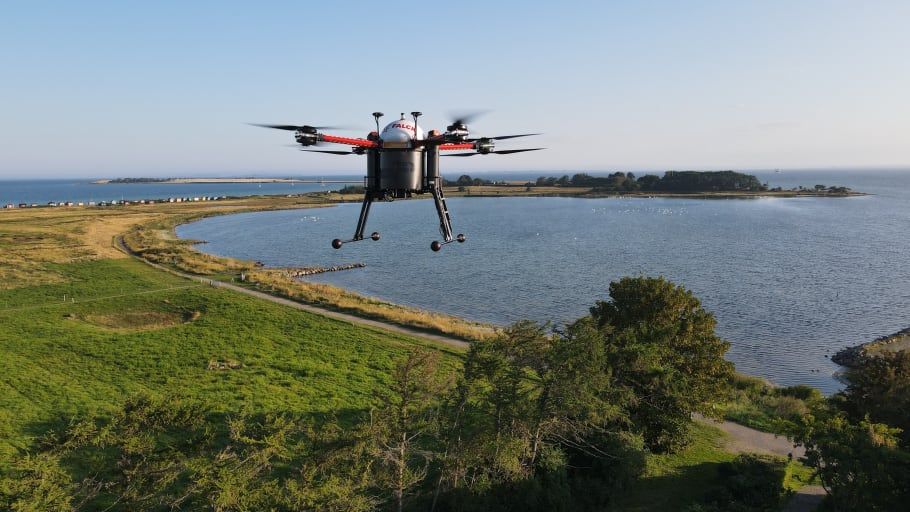NEWS

BVLOS in SAIL III
Nov 2022 - The German Luftfahrtbundesamt (FAA) certified the Globe UAV solution for BVLOS (Beyond Visual Line Of Sight) operations in SAIL III level according to EASA rules.
Required procedures like ERP, weather, PIC and crew management, as well as pre and post flight checks are embedded into the SkyGate Ground Control Station and reduce the administratory paperwork to a few clicks.
Ready to adapt the operation license for your project for transport or surveillance measures.
Copter testing at "better stay
home" conditions
Storm "Ignatz" delivered some excellent testing conditions with gusts up to 80km/h (50mph).
Optimized Starting Sequence
From Alarm to Airborne in 30 Seconds
When we started the system development, the idea was a early response on incidents - consequently the starting procedure of the Skyport is now optimized and much faster than before. A triggered alarm, an emergency call or a drone request by mobile will launch the Aquila or Ceptor within 30 Seconds.
Falck reaches new milestone with health drones on Ærø
Falck`s Ceptor V2 covered more than 180km in trial at 14th of February 2021
As part of the HealthDrone project in collaboration with, among others, Odense University Hospital and the University of Southern Denmark, Falck is now the first in Denmark to conduct test flights with drones in the open air and out of sight. In the long run, the drones will be used to transport blood samples and medication, which may contribute to faster diagnosis and treatment of patients in the future. The health drones of the future are now one step closer to becoming a reality. Falck has just started the first test flights with drones in the open air, and where the drone flies so far away that it can no longer be seen by the drone pilot. This is the first time this has happened in Denmark. The test flight takes place on Ærø and is part of a project under the name HealthDrone, which is supported by the Innovation Fund. In the long term, the drones will be used to fly blood samples from Ærø and Svendborg to the laboratory at Odense University Hospital.
Cementing leadership position in Europe
There are few places in Europe that have been granted permits to make flights in open space and out of sight. Thus, Falck and the HealthDrone project help to cement Denmark's position within Drone Flight further. “We are far ahead in Denmark in terms of test flights of drones, and with the test flights on Ærø we have taken a significant step.
The use of drones in healthcare has enormous potential that can bring citizens and patients who may live far from the nearest hospital closer to specialized help. In addition, blood samples and medicines, for example, can appear quickly. It will provide a faster diagnosis and better treatment and will benefit both the patients and the public health budgets, ”says Nicolai Søndergaard Laugesen, who is responsible for Falck's drone project. Drones must transport paramedics Falck's ambition is to make manned drones an integral part of its ambulance service in the long term. The goal is that by 2025, the first citizens will be treated by paramedics flying in drones. Although there is still a long way to go, technology is evolving rapidly.
And the test flights on Ærø are an important part of the collection of experience that is necessary to find out how drones can be integrated in special situations. “Our goal is to gain experience with where and how the technology can be used in future ambulance services. We have a good collaboration with the Danish Transport Authority, which has been an important partner, and together with researchers and the hospital service, we are working to find solutions that will ultimately benefit patients, ”Nicolai Søndergaard Laugesen. HealthDrone is a collaboration between the University of Southern Denmark, Odense University Hospital and Svendborg Hospital and Holo, Unifly, Scandinavian Avionics and Falck.
The project is supported by the Innovation Fund with DKK 14 million. kroner.
The project runs over a 3-year period.
Cologne / Nauen, June 7th, 2021 - Media Broadcast and Globe UAV have implemented the control of a drone for professional applications in a pure standalone 5G campus network for the first time worldwide. The results of this test form the basis for the further development of future usage scenarios in areas such as Industry 4.0, Public Safety or media, where criteria such as maximum reliability, unrestricted availability, low latency times and high data rates are among the basic requirements.
The use case was carried out in the standalone 5G campus network of Media Broadcast in Nauen near Berlin, which can be used by companies from all industries to test their own applications both indoors and outdoors on an area of several hundred square meters under real conditions.
To implement the Globe UAV drone, various parameters of the 5G core network were initially adapted to the special requirements of the aircraft. The subsequent tests provided extensive knowledge, which is now being incorporated into further development. The very low latency times of the 5G campus network, which are again significantly below the latencies of public 5G networks, noticeably improve the drone's response to control commands from the pilot.
Thanks to the very high bandwidth, which is unrestricted available in contrast to public networks, the image quality of the video sequences transmitted in real time by the drone is extremely high. With professional zoom lenses, razor-sharp images with the smallest details can be received even at greater distances.
“In the future, drones will play an increasingly important role in supporting production processes, security applications and mobility issues. We are pleased that we can support Globe UAV with our 5G campus network to further advance the development of innovative drone systems and even celebrate a world premiere together, ”said Daniel Wolbers, project manager for 5G campus networks at Media Broadcast.
“Drones in the security sector, perimeter protection and BVLOS flights are playing an increasingly important role. Many industrial customers will use 5G standalone networks in the future. Thanks to the very low latency of less than 20ms, control inputs to the UAV and the image transmission to the ground station can be implemented in real time. This means an enormous gain in safety ”, says Thomas Schommler, Solution Consultant from Globe UAV GmbH.

Bildtitel
Untertitel hier einfügenButton
Bildtitel
Untertitel hier einfügenButton
Action Plan for Drones
Scheuer's Third Dimension
Government opts for drone transport (BMVI action plan dated May 13, 2020)
Federal Minister Andreas Scheuer presented the Federal Government's action plan for Unmanned Aerial Systems and Innovative Aviation Concepts to the Federal Cabinet today. The aim is to enable the use of drones - and in the future also flight taxis - as a regular mode of transport.
Andreas Scheuer, Federal Minister of Transport and Digital Infrastructure:
We want to get drones - and in the future also flight taxis - safe into the air. For example, drones quickly transport essential medical goods to where they are urgently needed. Instead of being stuck in traffic, they fly over it on the shortest route. This is a big win, also for the supply of areas that are otherwise difficult to reach. We lay the foundation for this with our action plan. We promote the transition from laboratory to practice. At the same time, we are creating new and clear structures for safe drone flights. We are now ready to take off into the third dimension.
Thomas Jarzombek, Federal Aerospace Coordinator:
Drones have long been much more than a vague vision of the future or a gadget for amateur pilots. The drone economy is a growth driver, creates high-quality jobs and is a market with a future. The Federal Government would like to contribute to the development and use of unmanned aviation systems in Germany. The federal government's goal is that drones and flight taxis can leave the laboratories and go into the air. With the action plan we outline the framework: legally, socially, infrastructurally and environmentally conscious.
MEDIFLY HAMBURG
Successful Transport Solution for Medical Samples
with Globe UAV Ceptor 8L Transport
The joint research project Medifly, funded by the Federal Ministry of Transport and Digital Infrastructure (BMVI), successfully demonstrated the use of unmanned
aircraft systems (UAS) for the acute transport of medical samples on February 5, 2020 in Hamburg.
A total of six drone flights were carried out between the Bundeswehr hospital in Wandsbek-Gartenstadt and the Marienkrankenhaus in Hohenfelde at a distance of about five kilometers (linear distance).
The project became, among other things, the cover story of Drohnen Magazin in issue 02/2020,
www.drohnenmagazin.com
and the Drones in issue 03/2020,
www.drones-magazin.de
(Lufthansa Technik press from 05.02.2020)
AED Transport Project
MV|LIFE|DRONE
with University of Greifswald
Autumn 2019 - Globe UAVs Ceptor 8L Transport supported the MV|LIFE|DRONE Project to identify the advantages of Drone transport compared to common transport by ambulance in rural area.
Drone Operation in Romania
The Video has been recorded during an Operation in the Romanian Mountains supporting the MOI and Firebrigade with UAVs at estimated wild fires.
While the drone flight took part at site, the command center was 25km away in a town at the bottom of the mountains.
14
Years in Business
153km²
Test Flight Area
4.573
Hours in the Air
34
Projects










